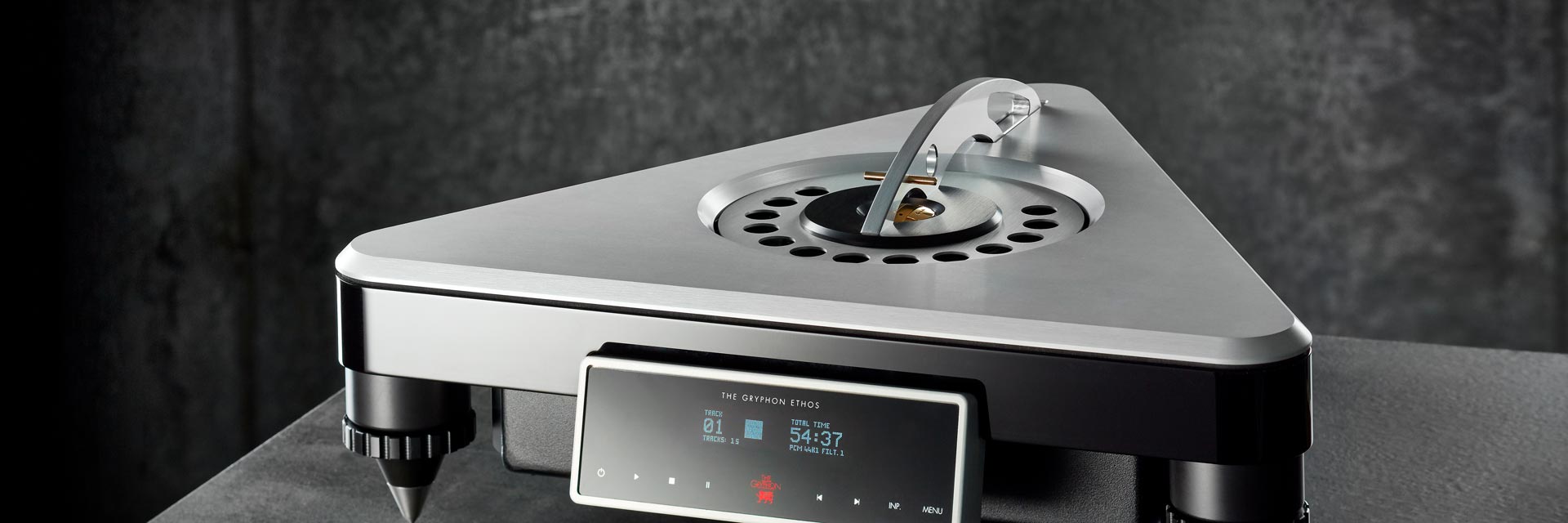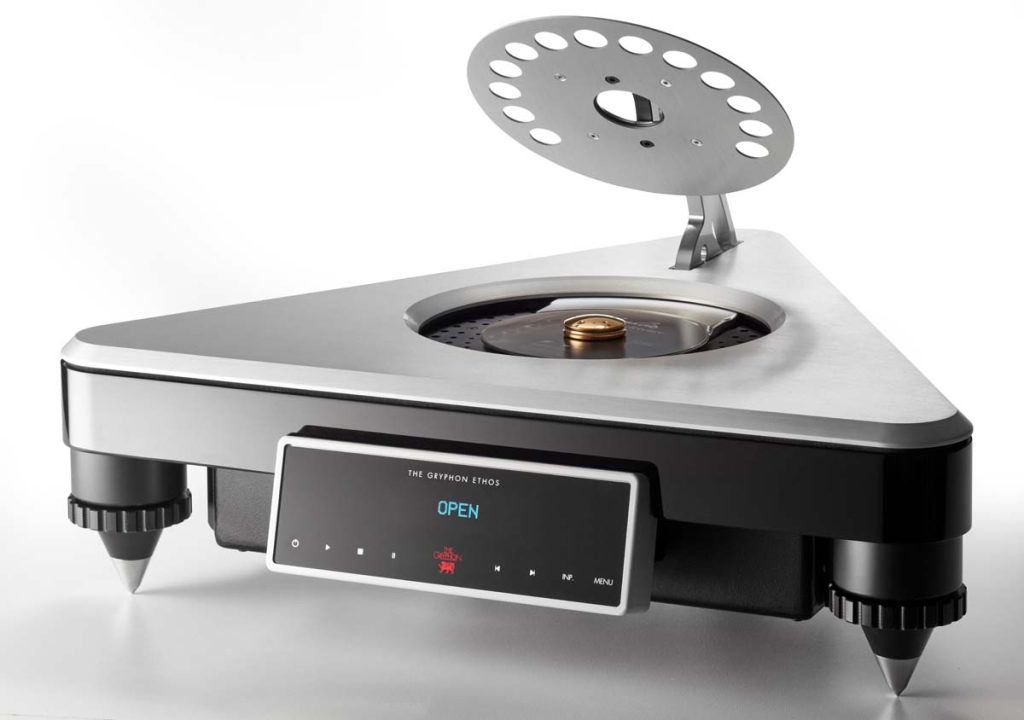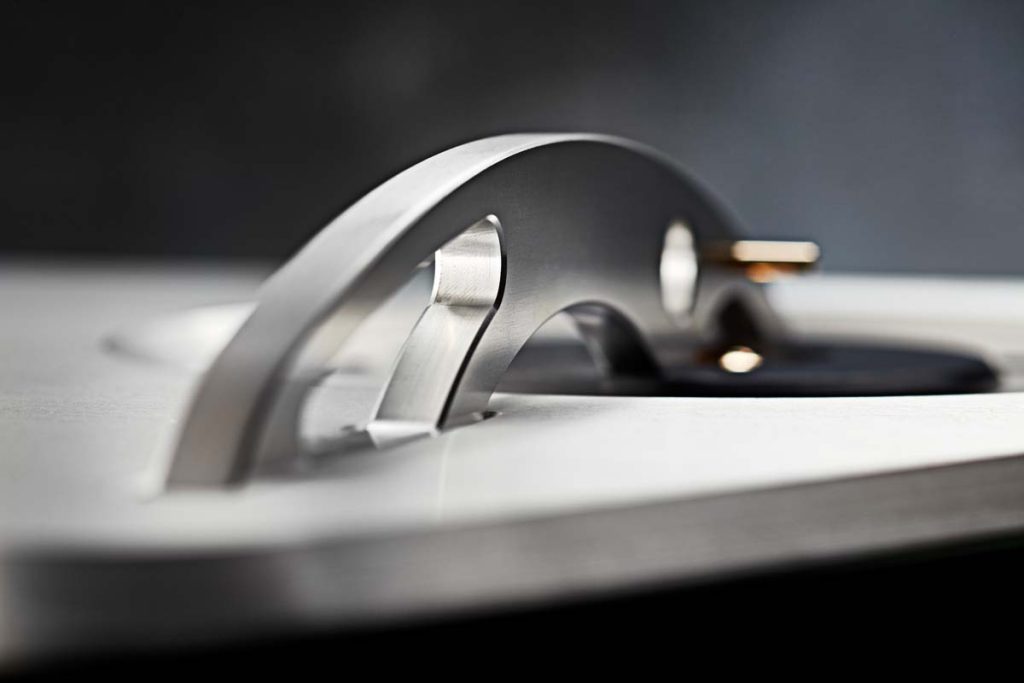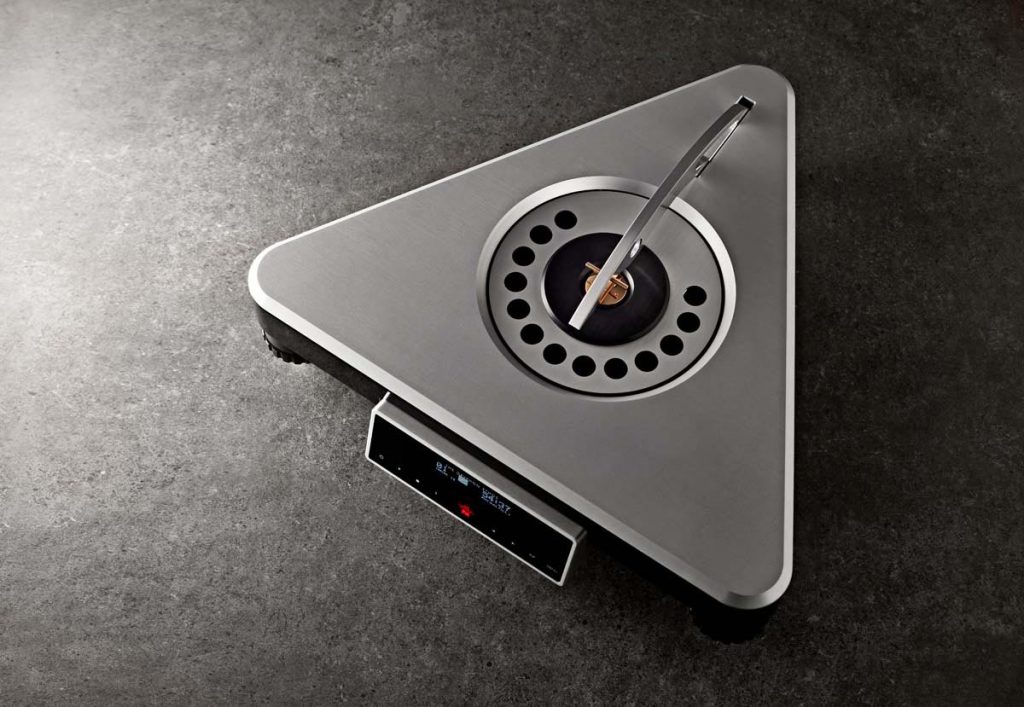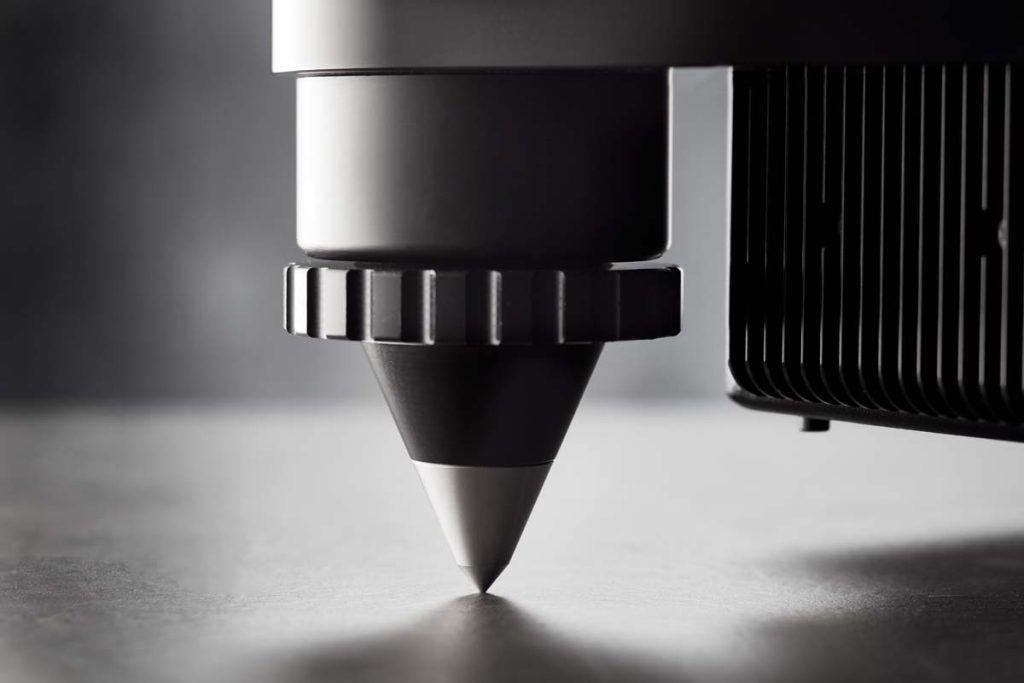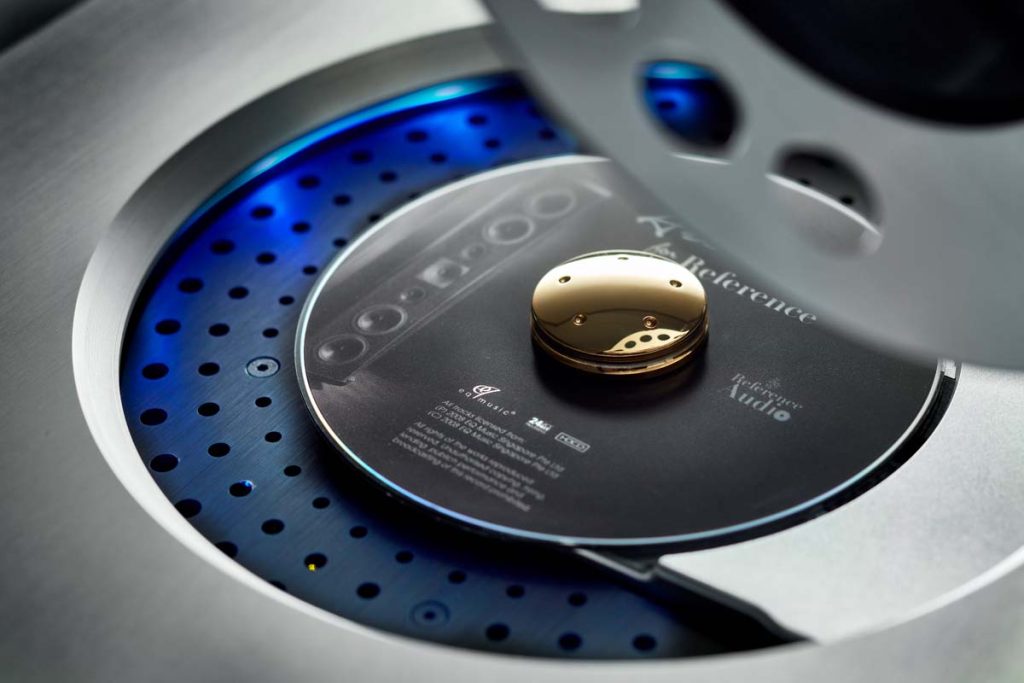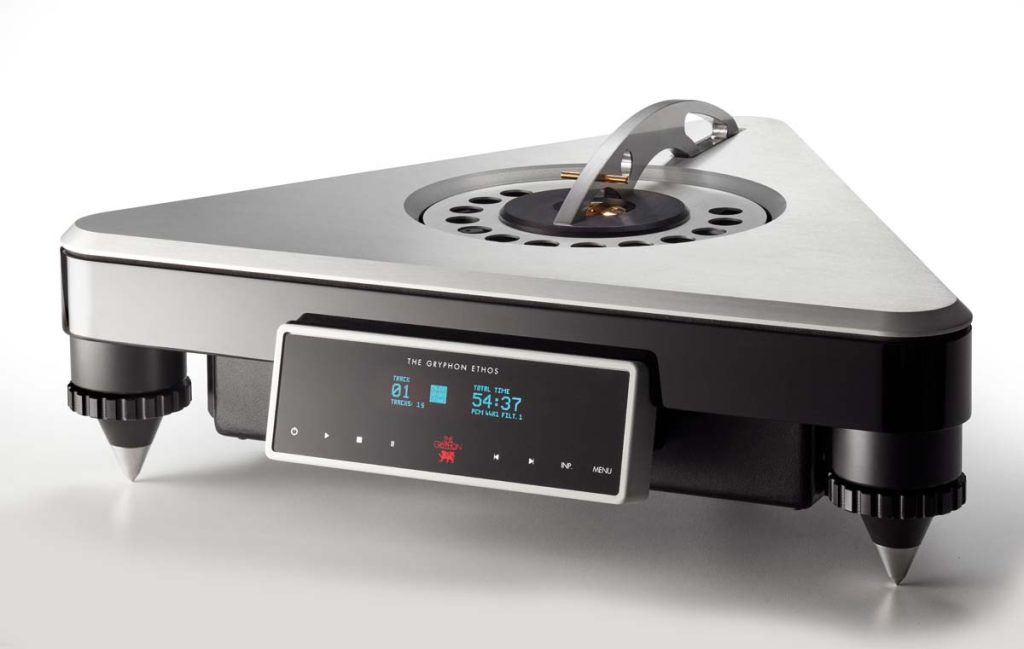It turns out there’s a quick and easy path to sweet audio bliss. All it involves is placing the magnetic clamp on the CD, lowering the lid and pressing the start button on the front panel. The clear menu prompts and refined look and feel of the Danish Gryphon Ethos top-loader provide a tantalizing taste of the audio quality it can achieve.
This CD-player design sets it apart in many ways, from its triangular base (designed by Flemming E. Rasmussen) and loading mechanism, right through to the majestic, touch-sensitive control panel on the front. Strictly speaking, the Gryphon Ethos is not just a CD player, but a 2-in-1 device consisting of a high-quality transport (CD-Pro 8 S) and a lavish digital-to-analog converter based on the ESS SABRE flagship ES9038Pro.
Every time that I fired up the Ethos, I gave it an hour or so to warm up. This audibly made what was already a very impressive sound profile even more cohesive. Then, I popped Rudy van Gelder’s remastered version of The Hawk Relaxes by Coleman Hawkins in the CD player. The Gryphon proceeded to build a spacious yet realistic soundstage, placing the saxophonist slap-bang in the center with the drums, bass, guitar and piano dotted around. The Van Gelder Studio recording room is completely clad in wood, and it was precisely this tone that the Gryphon conveyed in addition to the musical performance of the remarkably cheerful band. The chiff emitted as the mouthpiece reed created the sound was just as striking as the hefty bass-string boom on Ron Carter’s double bass. And the warm tone of Kenny Burrell’s electric guitar was laid-back, confident and almost casual as it left the loudspeakers.
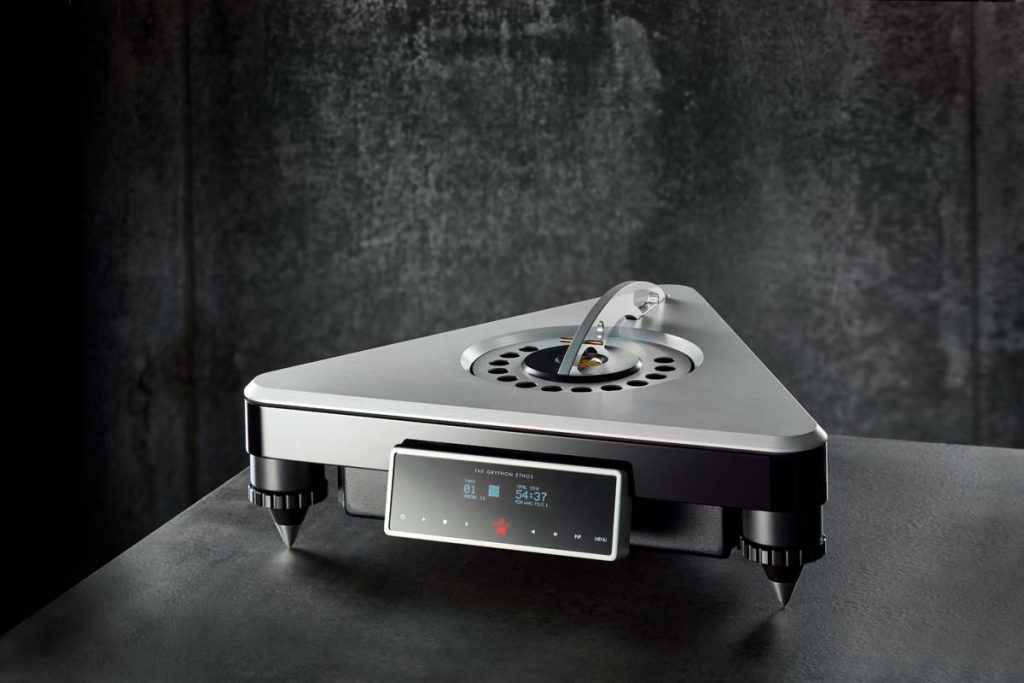
The Ethos turned what was already an incredible-sounding recording into a musical masterpiece. The dexterity of these five musicians was matched beautifully by the real sense of occasion. And this resulted in the interaction between the artists and the acoustic credentials of the recording studio. At no point did the Gryphon ever thicken certain frequency ranges, as lower-quality recordings tend to reveal their true colors quickly.
As I sat back, relaxed and listened to the quintet, I noted some of the more technical points of interest. Thanks to the fact that the triangular housing has a standard width of 48-centimeters, it can be placed on nearly any rack. The circular spirit level, included as standard, in conjunction with the three height-adjustable feet mean that you can quickly ensure the CD player is perfectly level. I placed the round leather pad, also standard, on the solid 4-millimeter thick aluminum plate so that I could remove the magnetic clamp whenever I changed the CD and safely avoid any scratches when setting it down. During playback, the clamp fixes the CD in place on the spindle of the StreamUnlimited transport (CD-Pro 8 S). In turn, the Gryphon plays CDs that exclusively meet the Redbook standard. This means that the Dane can’t handle SACDs or other disc formats. However, to be honest, they aren’t of any real importance anyway. Burned CDs can sometimes be a bit of an issue, though.
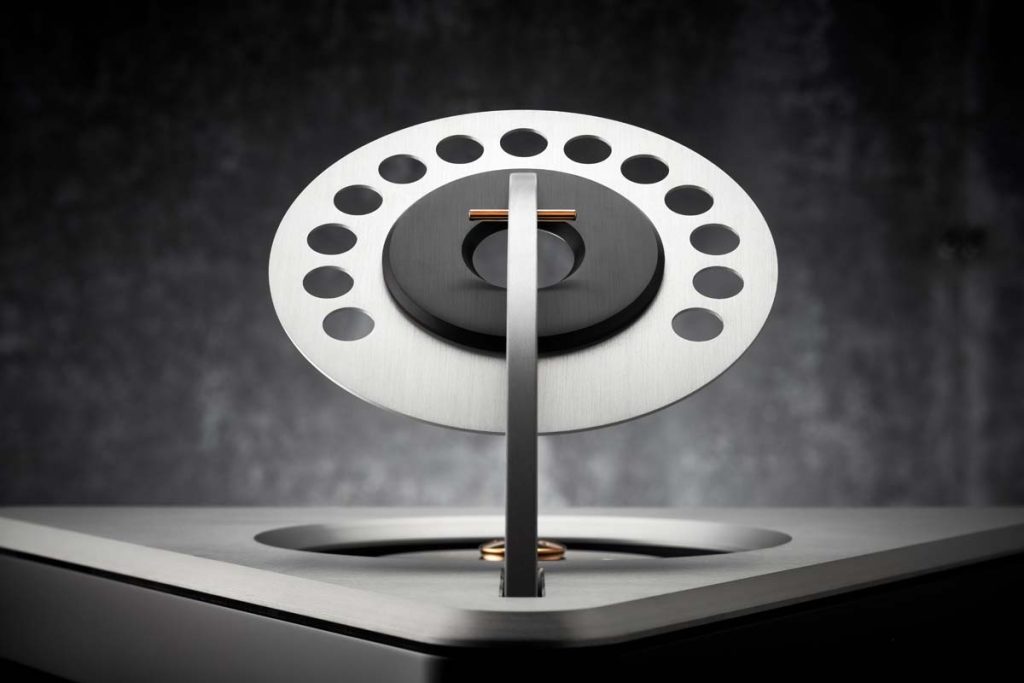
All of that being said, the Gryphon Ethos is not a pure CD player. It’s also a fully-fledged digital-to-analog converter. This meant that I could feed in hi-res music data, for example in PCM or DSD format, via the converter’s various digital inputs. The Gryphon’s ES9038Pro, which is currently the most powerful SABRE converter chip on the market, let me choose between seven PCM digital filters (and three DSD filters), as well as additional upsampling (including CD data). I found that filter 4 with upsampling was the most harmonious option. Although the differences between the filters may be very slight, they do let you subtly influence the sound profile. Furthermore, the upsampling is a real plus for listeners, as it adds even more air around the individual sound sources in any performance without forfeiting pressure. Gryphon Audio Designs deployed this technology in its first ever CD player, the CDP1, back in 1998 and has been constantly improving it ever since. In addition, two high-precision, temperature-compensated crystal oscillators – which set the exact clock rate and minimize jitter – help create the optimum working environment for the converter. The eight outputs of each of the two built-in ES9038Pro DAC chips enable the circuitry to be fully balanced both in the converter unit and afterwards. Moreover, the left and right channels are physically separated in the housing. The result? Dual mono!
The solid remote control makes it easy to change the settings and flick between tracks from the comfort of your preferred listening position. However, I also thoroughly enjoyed controlling the device through its touch-sensitive front panel display. The functional buttons, which are identified with icons, respond immediately, and the display is elegant, clear and legible. Just like the housing itself, this control unit also features solid, top-quality craftsmanship – which you would expect, given the asking price. However, I didn’t understand the run-of-the-mill thin power cable provided as standard. I wouldn’t be going out on a limb to say that they could easily have thrown in a high-quality cable and plug.
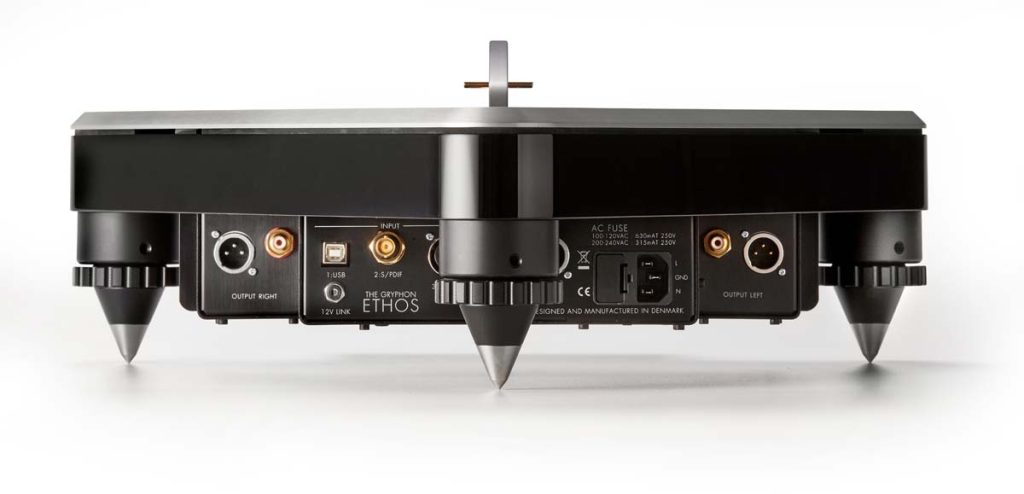
I put on the remastered version of Simple Minds’ album Street Fighting Years, which has a heftier bass than the original master from the 80s. Back then, when I bought the album, I wasn’t fully aware of the tonal depth that the producers Trevor Horn and Stephen Lipson had achieved with the Scots. The opening track’s orchestral arrangement normally sounds somewhat diluted and blurred and too complex for many playback chains. But this wasn’t the case with this CD player! Even when facing the most densely packed arrangement, it managed to pinpoint every instrument. The stereo positioning was extremely stable, and the soundstage depicted was once again truly expansive but never unnatural. Charlie Burchill’s guitars consistently found my ears, and I found myself nodding in approval. This guy is simply so good with his six strings and is underestimated by so many of his contemporaries. The Gryphon Ethos managed to follow the finest nuances of his performance with not only impressive accuracy and speed, but also a certain sense of swing. Even the shells of the drums sounded vivid. And this applied just as much to the batter head attack as to the subsequent fading out of the shell.
The Gryphon’s circuitry features a modular design, meaning that it can be upgraded to accommodate any future technical developments. The relevant modules, including the display, have separate power supplies. The analog output stages boast Class-A operation, free from any negative feedback, are driven by a separate transformer and are buffered by 20,000 microfarads of capacity for each analog channel! Developer Tom Møller has accomplished an astonishing job here.
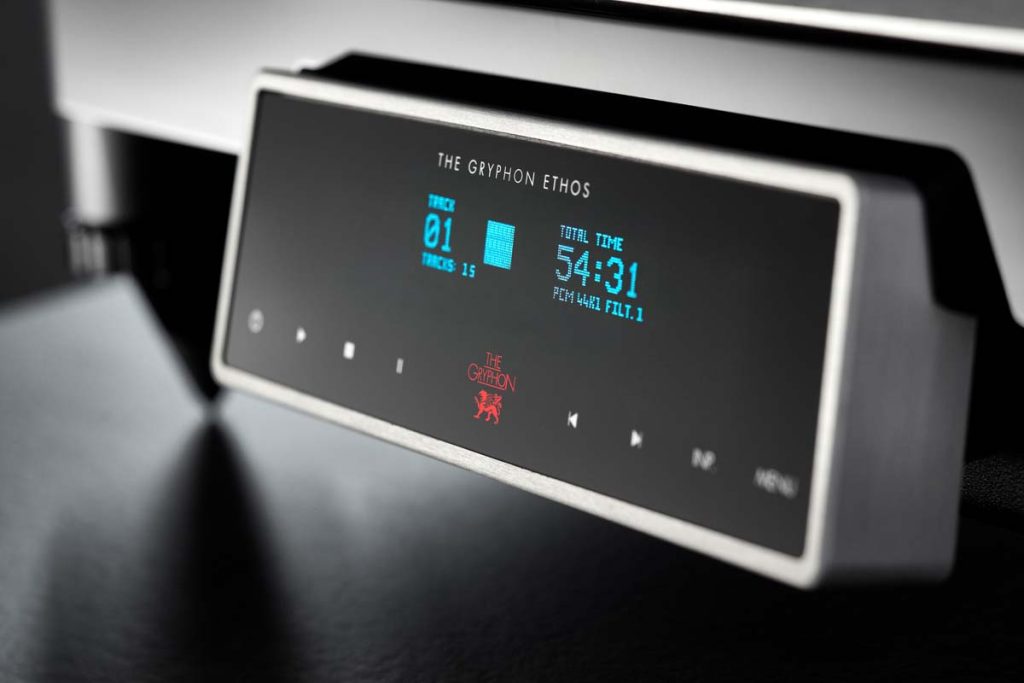
This also applies to the USB input, whereby the work of the corresponding module is virtually battery-buffered thanks to an unbelievable capacity of 12.5 farads. Logically, my next step was to connect my MacBook to the Gryphon using a high-quality USB cable.
Without any driver, the DAC was immediately recognized as “Ethos USB” and we were good to go (incidentally, Gryphon provides corresponding drivers for Windows). Triosence recorded their new album entitled Giulia in Italy, and they managed to convey and capture the airiness of the rolling Tuscan landscape in their own compositions. I played the album in 24-bit and 96-kilohertz format. Even here, I felt that the selected upsampling created more space around the individual notes. Bernhard Schüler’s piano, which was given a decent amount of space, sounded even grander with the upsampling, and it could clearly better emit the sound waves created by the instrument throughout the room. This may sound a little esoteric, but it really was my impression of the audible difference between the two modes. The Ethos’ display informed me of the incoming digital resolution and the selected filters. The sound emitted from the loudspeakers was natural, transparent and homogeneous.
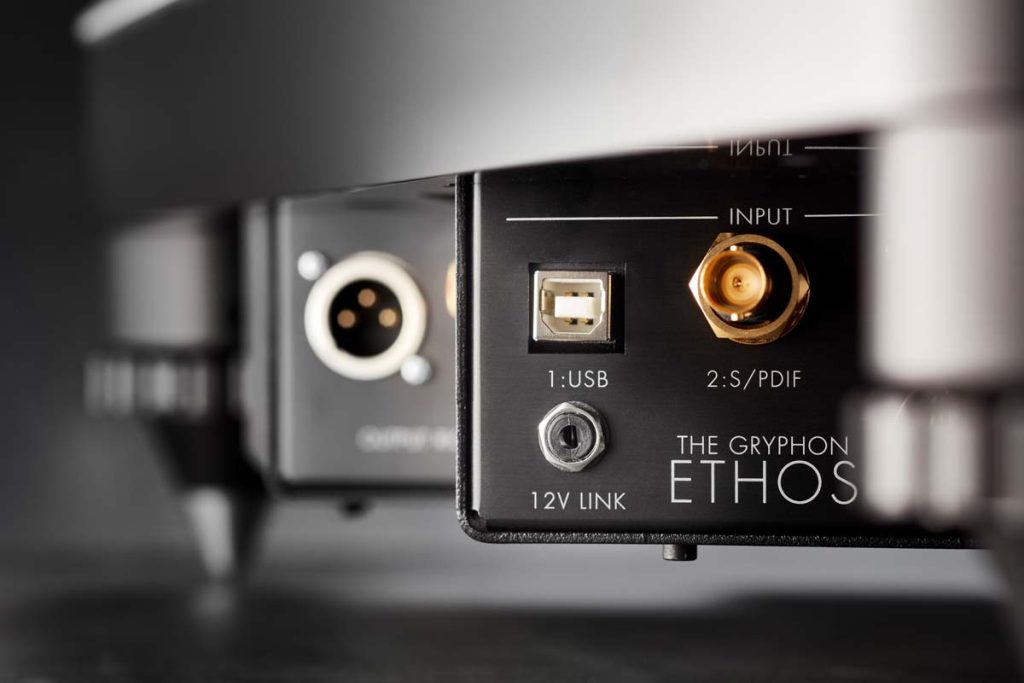
Just like when I was playing CDs, the pure converter unit showcased this outstanding soundstage as being expansive but never unnatural. Omar Rodriguez Calvo’s double bass was either powerfully percussive and snappy, or tremendously soft and smooth, depending on play style. And the Gryphon Ethos enabled me to pick up on these intricacies without having to constantly think about sound quality. But this is intentional, as the Danish digital player – made in the interests of the listener – is all about the music as opposed to focusing on the technology. Although the technology is the ultimate example of perfection even underneath the aluminum plate, it’s just the vehicle and reason why the Gryphon Ethos sounds so musical yet still manages to look so unpretentious. Anyone who’s aware of their own strengths doesn’t need to shout it from the rooftops, rather they just sit back and let their hard work do all the talking!
Yet there was one more thing I wanted to know: How would the same album sound on a CD compared to the digital version via USB? I opted for John Mayer’s accessible album Sob Rock, which is heavily influenced by Mark Knopfler’s style. I know this album inside and out in all formats, including vinyl. “Wild Blue” was played in 24 bit/48 kHz via USB. The drums ventured deep into the darkest depths of the bass frequency, the snare remained gently compressed in the heart of the performance, and Mayer’s voice featuring a slight chorus effect broke free from the other instruments. Here too, it had requisite conviction without ever sounding larger than life. The Knopfler-esque guitar solo fizzed like a fresh cold drink through the loudspeakers, while the rhythm section continued stoically celebrating the groove.
Next, I switched to the CD. The entire sound profile shifted slightly towards the middle, between the loudspeakers, and seemed to be even faster and more focused. John Mayer’s voice became a little more prominent. Overall, the whole thing had just a bit more swing. In my opinion, this demonstrated the whole raison d’être of such a high-quality transport as this top-loader featuring the CD-Pro 8 S. The downstream converter unit faithfully passed on the differences between a good transport and external digital data to the system, all without ever misappropriating its magnificent spatial reproduction.
Aside from the eye-watering purchase price, this CD transport plus exceptional converter unit is one of the best and most unique and refined-looking models available on the market today. In terms of pure sound quality, this is right on the money.
ESS SABRE FLAGSHIP ES9038PRO
The Gryphon Ethos’ two built-in premium ESS Technology chips work with 32-bit resolution and – in the mono operation used here – have a signal-to-noise ratio of an incredible 140 decibels. For the core, the input and output section and the actual converter, the chip requires a separate power supply in each case to be able to separate sensitive units from each other – even in the tightest spaces. This corresponds perfectly with the Gryphon’s balanced dual mono set-up, which also justifies the use of an “off -the-rack” chip. All of the available eight digital filters can be individually configured.
CD Player/DAC
Gryphon Audio Designs Ethos
Concept: CD transport and DAC with fully balanced signal path in dual mono set-up, battery-buffered USB input | Inputs: digital AES/EBU XLR, S/PDIF coaxial and optical, buffered USB-B socket for external computers | Outputs: digital AES/EBU XLR, analog balanced XLR and unbalanced RCA | Formats: 22 kHz to 192 kHz PCM via S/PDIF and AES/EBU, via USB PCM to 384 kHz and DSD512 with maximum 32-bit word length (DSD256 and DSD512 only via Windows) | Finish: steel and aluminum silver or black, touch-sensitive display | Features: remote control included as standard | Dimensions (W/H/D): 48/17.6/45.3 cm | Weight: 13.7 kg l Warranty period: 3 years | Price: approximately €35,700
Gryphon Audio Designs APS
Industrivej 10b
8680 Ry
Denmark
www.gryphon-audio.dk
Accompanying Equipment
CD player/DAC: Luxman D-N150 | Integrated amplifiers: Luxman SQ-N150, Econaudio IA3000 | Streamer: Volumio | Headphone amplifiers: Graham Slee Solo, SPL Phonitor One | Headphones: Shure SRH-1540 | Loudspeakers: Wilson Audio Sasha DAW, Børresen Acoustics Z5 Cryo Edition, Klipsch Heresy IV | Cables: Ecosse, TaraLabs, HMS, Furutech

